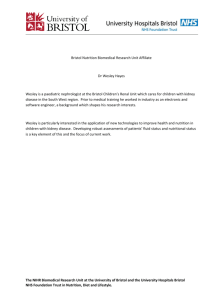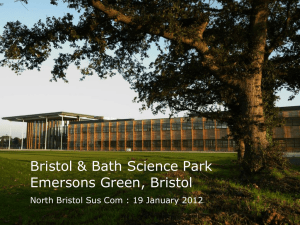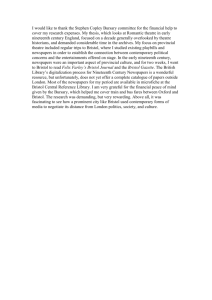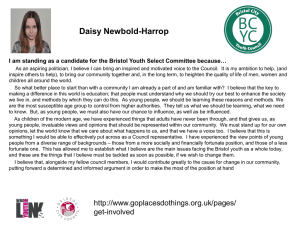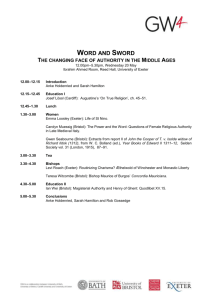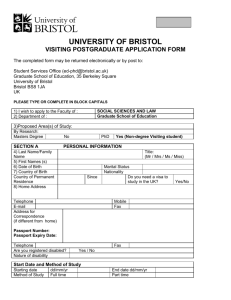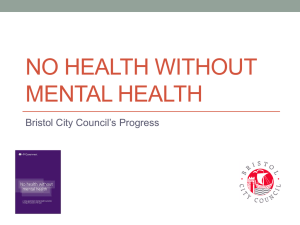Teacher Notes - Trail H
advertisement
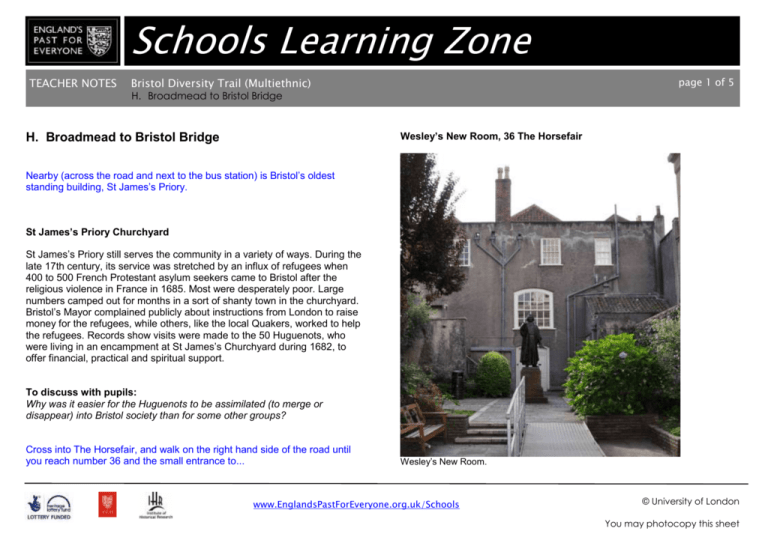
Schools Learning Zone TEACHER NOTES page 1 of 5 Bristol Diversity Trail (Multiethnic) H. Broadmead to Bristol Bridge Wesley’s New Room, 36 The Horsefair H. Broadmead to Bristol Bridge Nearby (across the road and next to the bus station) is Bristol’s oldest standing building, St James’s Priory. St James’s Priory Churchyard St James’s Priory still serves the community in a variety of ways. During the late 17th century, its service was stretched by an influx of refugees when 400 to 500 French Protestant asylum seekers came to Bristol after the religious violence in France in 1685. Most were desperately poor. Large numbers camped out for months in a sort of shanty town in the churchyard. Bristol’s Mayor complained publicly about instructions from London to raise money for the refugees, while others, like the local Quakers, worked to help the refugees. Records show visits were made to the 50 Huguenots, who were living in an encampment at St James’s Churchyard during 1682, to offer financial, practical and spiritual support. To discuss with pupils: Why was it easier for the Huguenots to be assimilated (to merge or disappear) into Bristol society than for some other groups? Cross into The Horsefair, and walk on the right hand side of the road until you reach number 36 and the small entrance to... Wesley’s New Room. www.EnglandsPastForEveryone.org.uk/Schools © University of London You may photocopy this sheet TEACHER NOTES page 2 of 5 Bristol Diversity Trail (Multiethnic) H. Broadmead to Bristol Bridge Entry is free; for opening times and further details visit: http://www.newroombristol.org.uk/ Friend’s Meeting House, Quaker’s Friars John Wesley(1703-1791), founder of the (Christian) Methodist Church and an ordained priest in the Church of England, was moved to preach the word of God to communities across Britain, and travelled nearly a quarter of a million miles during his lifetime – choosing to speak to crowds of ordinary people rather than just to the wealthy. Huge crowds of workers came to listen; he gave his first open-air sermon near Avon Street at St Phillips Marsh in Bristol on 2 April 1739, and his last in King Square on 29 August 1790. Wesley bought the plot of land on 9 May 1739, and started building on the 12 May. The building is now kept as it would have been at the time it was used by Wesley, his brother Charles (1707-1788) and his family. The Wesleys were strongly supported locally by the Gloucester-born evangelical preacher George Whitefield (1714-1770), a prominent figure in the establishment of the Methodist movement, and had financial support from Selina Hastings, The Countess of Huntingdon (1707-1791), who gave funds for the building of Methodist chapels in Bath and Bristol. Services and meetings are still held here, and the small museum provides further information about its link to a worldwide movement. Charles Wesley was a strong public speaker as well as a prolific sermon and hymn writer; he is well known for ‘Hark! The Herald Angels Sing’. Go through the building to Broadmead (or if it is closed go slightly further and walk through The Arcade to Broadmead), before turning left and walking to the circular centre of the shopping streets. Turn right, then left into Quaker’s Friars. Friends Meeting House, Quaker’s Friars. The group of buildings known as Quaker’s Friars are the remains of a Dominican Friary founded around 1228 and closed by Henry VIII in 1538. After this it became The Cutlers' Hall, The New Hall, The Bakers Hall and then the Religious Society of Friends (Quaker’s) Meeting House. The Bristol Quaker community was heavily persecuted by some of the Anglican ruling class during the 17th and 18th centuries. One especially notorious Sheriff of Bristol, Sir John Knight, carried out a long campaign of arresting and fining Quakers, and in 1681 had the Meeting House building wrecked and sealed – imprisoning many adult Quakers in the Bridewell. The part which was the Friends Meeting House was built in 1747-49, principally by George Tully and with further work by Thomas Paty. www.EnglandsPastForEveryone.org.uk/Schools © University of London You may photocopy this sheet TEACHER NOTES page 3 of 5 Bristol Diversity Trail (Multiethnic) H. Broadmead to Bristol Bridge For further information about the history of Quakerism in Bristol visit: http://www.csm.uwe.ac.uk/~rstephen/livingeaston/local_history/quakers.html To discuss with pupils: Should there be interpretation boards describing the different religious communities in Bristol at the sites of these historically important places of worship? From Quaker’s Friars cross onto Castle Green (the site of the medieval castle). The castle was ordered to be destroyed by Cromwell after the Civil War of the 1640s. Quite a lot of the stone ended up being sold off for other buildings, and then the 1940-41 bombing destroyed them; a lot of the rubble was used for ships ballast in vessels going to the USA and was dumped to form a new harbour in the USA. Castle Park Sugar Houses (now destroyed) Castle Park covers what was once Bristol’s main shopping area, with small streets and the remains of the 13th century stone city walls. After the civil wars of the 1640s Cromwell had ordered the destruction of the castle, but many old buildings remained until a German bombing raid in 1941 flattened the city centre. The sugar houses were a link to Bristol’s slave trading and colonial past, but are now entirely gone. Nearby stood the offices of... Felix Farley’s Bristol Journal Bristol’s early newspapers were printed in the premises of the Farley family in this area from the 18th century onwards. The Farley brothers had a huge disagreement in 1751, probably about religion, and split the partnership and the company. Felix appears to have been a Methodist and Samuel a Quaker. The feud continued until they both died in 1753, and continued over the next twenty years between their descendents. In the centre of the park stands... St Peter’s Church This church was founded before the Norman conquest, alongside the sunken way (road) that led to and from the original Saxon settlement by the bridge. The remaining main sections of the church date from c.1100 to c.1400. Standing at the heart of the old city, St Peter’s was burnt out as a result of bombing during the Second World War, its roofless walls left standing as a memorial to civilian dead of the Bristol Blitz. The church was once home to a number of memorials, now destroyed or relocated, which showed the diversity of Bristol’s past, this included the brass memorial to the Irish priest and Newgate schoolmaster, Robert Londe dated 1462, who is recorded as paying the Alien Subsidy (a tax on foreigners), in the 1430s and in 1440s. Londe is recorded as paying the fee for a Licence to Remain in 1430, after the Crown ordered the Irish to leave. In 1440-41 Londe again paid the Alien Subsidy, a charge on residents from lands outside of the King’s Lordship, a tax on foreigners. This was somewhat unfair since Ireland was notionally under the control of the English Crown, and both the Irish and those born in the English-controlled parts of France were exempt from later versions of the tax. www.EnglandsPastForEveryone.org.uk/Schools © University of London You may photocopy this sheet TEACHER NOTES page 4 of 5 Bristol Diversity Trail (Multiethnic) H. Broadmead to Bristol Bridge A building in Temple Street, known as The Stone Kitchen, housed the synagogue between 1756 and 1786. The Weaver’s Hall in the same street housed worship until 1842, although a disagreement in the community between 1825 and 1835 resulted in a second synagogue being used in a building between Temple Street and Temple Back. In 1842 worship transferred to a room in the Quaker Meeting House, in a courtyard off Temple Street. The opening ceremony was attended by local Church of England, Methodist and Baptist ministers, as well as Quakers. This showed increasing tolerance and changing attitudes in the city. The community used this space until transferring to the city’s first purpose built synagogue in Park Street. St Peter’s Church, Castle Green. To discuss with pupils: The Castle district was blitzed and destroyed during the Second World War. Is there enough here to help people understand the historic nature of this area? Should this land, which is worth millions, stay as a park? Cross the park to Queen Street, walk down Passage Street, cross the water of the Floating Harbour via St Phillips Bridge. At the start of Counterslip, turn left into Temple Street where the local Jewish community worshipped in the 19th century. Temple Street synagogues (this area was destroyed during the Blitz) During the 19th century the Temple district was a series of small streets, low quality houses and factories near to the city’s railway station. It was an area which was home to low paid workers and many immigrant families, including central and Eastern European Jews, many of whom were escaping oppression in their homelands. A series of buildings were used in the area as places of worship for the local Jewish community, all of which have now gone. Continue to Temple Church and Gardens. Temple Church The Order of the Knights Templar, disbanded by the Pope in 1307, were given the land in this area in 1145 by Robert De Berkley. They built a small church and community here, later building a circular church, in the late-12th century. The area is known as Temple Meads (Templar Meadows). The current church on the site was built in the 14th century, but was burnt out along with about one quarter of the old city during the 1940-1941 bombing. The Order of the Knights Templar, or to use their full title ‘the Poor Knights of the Temple of Solomon of Jerusalem’, were established in 1118 based on a group of nine soldier-monks who had sworn to protect pilgrims travelling to Jerusalem. The order was disbanded by the Pope in 1307 having created powerful enemies, including Philip IV of France who was heavily in debt to the order. www.EnglandsPastForEveryone.org.uk/Schools © University of London You may photocopy this sheet TEACHER NOTES page 5 of 5 Bristol Diversity Trail (Multiethnic) H. Broadmead to Bristol Bridge In Bristol, Robert De Berkley donated land to the order in 1145 and a small church and community was founded locally. St Nicholas Church There has been a church on this site since at least 1154; the current version was rebuilt between 1762 and 1769 after a road widening and bridge replacement scheme. It was built to a design by James Bridges, and the spire was designed by Thomas Paty. St Nicholas is built over the medieval walls of the city, and has 14th century features in its crypt with other original fittings. Inside there are wall memorials to Huguenot settlers and others. For centuries the church was at the centre of the local community, until war damage and 20th century fashions for living outside of the city depleted the community. Towards the end of the 20th century the church was used as a museum by the city council, but now only opens to the public on special occasions. Look out for scars from 1941 Blitz damage. You have now returned to ‘the place of the bridge’. Temple Church. Walk the few metres to Victoria Street, and turn right to head back to Bristol Bridge. Across the bridge you will see... Bristol Bridge from Castle Green. www.EnglandsPastForEveryone.org.uk/Schools © University of London You may photocopy this sheet
